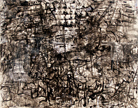Kathryn Arnold at David Levik Gallery, Kansas City |
|
The Kansas City Star
6/24/94
by Alice Thorson
“Artist’s Works on Paper a Tantalizing Thicket for Viewers”
The ranks of intriguing women painters in Kansas City is on the rise. Over the last couple of years emerging artists such as Lana E. Turner and Megan Whitmarsh have joined veterans like Sharon Patten in producing strong work.
Other interesting recent developments include fiber artists Jane Lackey’s forays into painting and promising starts by Kim Anderson and Jill Hadley Hooper.
On the merits of her current exhibit at David Levik Gallery, 1721 ½ Westport Road, Kansas City artists Kathryn Arnold should be added to the list.
Arnold recently has shown at the KU Regents Center and Park College. Levik elected to show a series of her works on paper.
The “Nineties Beat Paintings,” as they are called for their alignment with beat poetry, display fervid layered markings in a variety of media, including ink, watercolor, pastels, pencil, acrylic and enamel paint and collaged elements.
Prominent among the latter are multitudinous little cranes created from folded paper. Installed amid a subconscious thicket of the drips, marks and fragmented texts that represent Arnold’s distillations of dreams, feelings and events, these origami cranes exert a talismanic and ordering presence.
In her artist’s statement, Arnold remarks on the crane’s role in Japanese legend as a vehicle of individual transcendence.
Several pieces incorporate diagrams, drawn on narrow horizontal strips and collaged onto the surface, showing how to make a folded crane. This simple creative act becomes an overarching metaphor for the transformative aims of the work as a whole.
The diagrams, like the paper cranes, speak of a deliberate and centered activity amid the cacophony of autographic marks and proclamatory words that stretch from edge to edge of these, on average, 5- by 4-foot expanses.
The palette here is predominantly and vividly black and white. Arnold uses color sparingly for punctuation and emphasis. The compositions tend to hinge on the placement of the cranes, which frequently roam haphazardly through the scaffoldings of black and white marks.
On occasion, the artist marshals the cranes into clustered formations — grid patterns, or, as in “Cloud of Cranes,” a cloudlike mass — that exert first claim on the eye.
But the viewer is perhaps happiest when allowed the freedom to roam at will through the more critical responses
|
|
|

